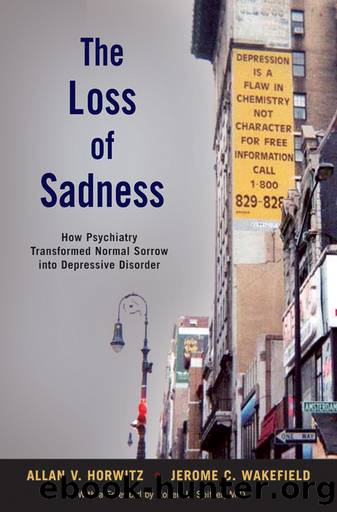The Loss of Sadness by Allan V. Horwitz

Author:Allan V. Horwitz
Language: eng
Format: epub
Publisher: Oxford University Press
Published: 2015-06-15T00:00:00+00:00
Fallacies Behind the âMinor Depressionâ Movement
What is right and what is wrong in the proposed expansion of disorder to include âminor depressionâ that has fewer symptoms than the DSM requires? What is right about it is, first, that we do need to be alert to subthreshold conditions in some circumstances in which they can help predict future problems. But the fact that a condition is a risk factor for future problems does not make it a disorder, a point to which we return subsequently.
Second, and most important, the DSM cutoff is somewhat arbitrary and is not a magic dividing line between pathology and normality. No doubt some sub-threshold conditions deserve to be diagnosed as disorders; also, DSM criteria for depressive disorder likely do yield some false negatives, in addition to the false positives we have emphasized. More generally, viewing depression as continuous rather than categorical has a number of theoretical advantages. 82 Many disorders, such as depression, might naturally be based on underlying, continuous dimensional processes rather than on dichotomies, and so continua might be more likely than diagnoses to âcarve nature at its jointsâ and yield fruitful research and theory.
However, the assertion that, because there is a linear relationship between number of symptoms and impairment, each point along the continuum therefore represents a disorder is highly problematic. When all symptoms are counted as disordered, ordinary sadness is hopelessly confounded with genuine dysfunction, and prevalence rates reach even more untenable levels than they do now. For example, in the ECA study, the most common symptoms are âtrouble falling asleep, staying asleep, or waking up earlyâ (33.7%), being âtired out all the timeâ (22.8%), and âthought a lot about deathâ (22.6%). 83 College students during exam periods (particularly those studying existential philosophy), people who must work overtime, those who are worrying about an important upcoming event, or respondents who take a survey around the time of the death of a famous person would all naturally experience some of these symptoms. Symptoms that neither respondents nor clinicians would ever consider as reasons for entering mental health treatment nevertheless can indicate disorder in community surveys. Moreover, the duration criteria require that the symptom last for only a 2-week period, ensuring that many transient and self-correcting symptoms are counted as disordered.
Given the common nature and brief persistence of many putative symptoms of depression, it is difficult to imagine that there are many people who have not experienced episodes of mild or subthreshold depression at some point in their lives, although there certainly are some people with temperaments that seem to virtually preclude intense sadness. Indeed, the very high rates of depression found when cutting points are lowered almost certainly underestimate the number of people who experience putative symptoms of depression. One reason for undercounts is that respondents do not recall all symptoms that have occurred at some point in their lifetimes. One group of researchers, for example, found that most respondents who reported episodes of lifetime depression at the baseline interview in the ECA failed to report any lifetime episodes at the 12-year follow-up period.
Download
This site does not store any files on its server. We only index and link to content provided by other sites. Please contact the content providers to delete copyright contents if any and email us, we'll remove relevant links or contents immediately.
The Art of Thinking Clearly by Rolf Dobelli(8873)
The 5 Love Languages: The Secret to Love That Lasts by Gary Chapman(8531)
Mindhunter: Inside the FBI's Elite Serial Crime Unit by John E. Douglas & Mark Olshaker(7851)
Becoming Supernatural by Dr. Joe Dispenza(7121)
The Road Less Traveled by M. Scott Peck(6650)
Nudge - Improving Decisions about Health, Wealth, and Happiness by Thaler Sunstein(6644)
Enlightenment Now: The Case for Reason, Science, Humanism, and Progress by Steven Pinker(6416)
Win Bigly by Scott Adams(6328)
Mastermind: How to Think Like Sherlock Holmes by Maria Konnikova(6257)
The Way of Zen by Alan W. Watts(5813)
Factfulness: Ten Reasons We're Wrong About the World – and Why Things Are Better Than You Think by Hans Rosling(4033)
The State of Affairs by Esther Perel(3946)
Gerald's Game by Stephen King(3928)
Man's Search for Meaning by Viktor Frankl(3649)
The Confidence Code by Katty Kay(3576)
Thinking in Bets by Annie Duke(3542)
The Worm at the Core by Sheldon Solomon(2929)
Enlightenment Now by Steven Pinker(2925)
Liar's Poker by Michael Lewis(2822)
